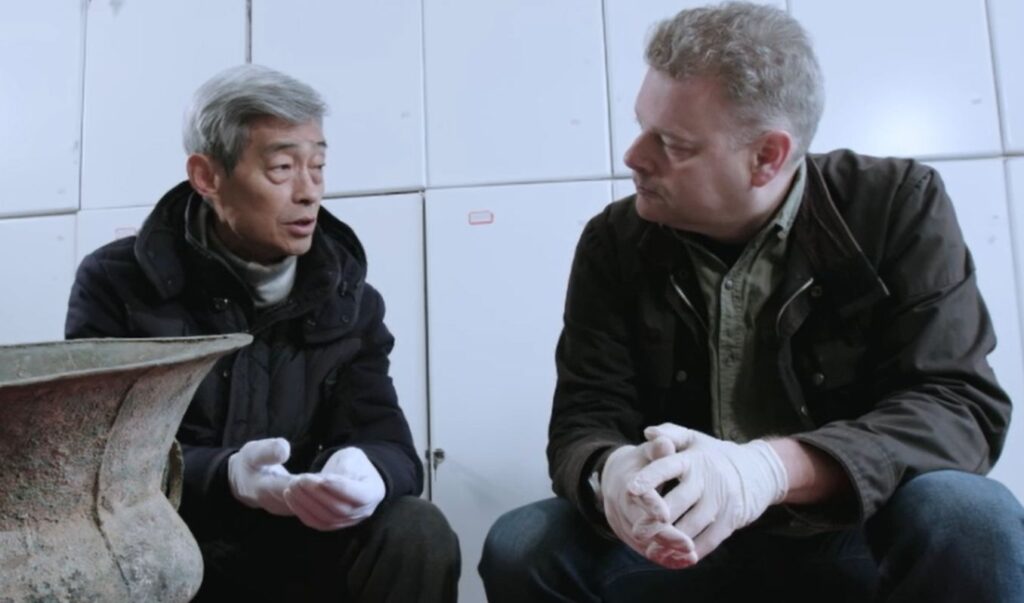Pot Heads | The Official Schoolgirl Milky Crisis Blog


Liang Taihe is showing me a big copper pot. We don’t quite understand what it was for, he says. They must have performed some ritual purpose. This one has carbon-scoring at the bottom, so it was previously used for cooking something, but the thing about the ancient Yelang people was that when they buried someone of great importance, they would stick one of these on their heads.
Right then, so they were nutters.
I think, he says, that they put them on their heads in the ceremonies as well. Like magic hats.
I have my own theory, which is that since many scholars have argued that these pots served some sort of ritual purpose in life, possibly the leaders of the Yelang were shamans, and that in life they would boil up some sort of trance-inducing concoction and stick their heads in to breath up the steam.

Professor Liang looks at me as if I am mad.
And then, I say, they see the spirits. And when they die, they put the pot on their heads because they will be with the spirits always.
Okay, he says gingerly, let’s put that one on the back burner, shall we?
Like the Dian people of Yunnan, with whom they shared a border, the Yelang people left no written records, and much of what we have to go on about them is only divinable from the metalware in their graves. The archaeological record shows a bunch of pot-headed burials, particularly in a village called Kele two hours outside Hezhang. It also shows bronzeware with multiple influences from outside, including a ge dagger-axe with a taotie design clearly from the Central Plains of China, and a short sword with a hilt made in Yelang, but a blade shipped in from Sichuan.
Late in the Han dynasty, the Yelang rebelled. The access to silk that they were promised turned out to be the thin end of an imperialist wedge, and when they tried to fight back against the Han, they finally discovered just how much bigger and better prepared the Chinese were. The last king of Dian was beheaded, and many of his people fled south. Archaeologists in the hills of Laos and Cambodia have found graves occupied by lone figures with pots on their heads.

There’s a lot of argument about where Yelang actually was. It’s widely believed that it was in Guizhou, and the fact that the pot-headed burials show that there was a culture of some sort here seems to suggest that it was the Yelang heartland. “Heartland,” however, isn’t good enough for the tourist authorities, who ten years ago tried to bribe Professor Liang to proclaim that Hezhang was the “capital” of Yelang. He took their money, went onstage, and told them all that the notion of a capital in those times was a free-floating concept. People moved around, populations were lower, and frankly, “capital” is a modern term and with that in mind, they could have their bribe money back. Then he walked off the stage.
I associate Guizhou with discomfort. Two years ago, I spent a miserable week up a mountain here, washing in cold water and eating unmentionables. The food is much the same – since arriving here I have been assailed by pig’s ears and chicken foot soup. You should try our bowl-covering pork, says the Propaganda man. It’s a slab of pork so large that it covers the whole rim of your rice bowl.
Which sounds nice, except that half the slab is pure fat.
Have a pig’s trotter, he says, shoving one in my face.

The new Guizhou Provincial Museum is supposed to look like something famous, but none of us can work out what it is. Possibly a pile of Lego. We’ll be filming here tomorrow with Professor Liang, when it’s closed to the public, but the museum is oddly under-attended, even on a Sunday, so we get pick-up shots of all the things he is liable to be pointing at.
He is aghast at the displays, and claims to have sent the curators a list of 200 points of contention.
“These bracelets are wrong,” he says. “I found them all on the arm of one skeleton. They need to be put together in a series to understand them, but they’ve just stuck them under glass separately, like we’re in some kind of shop. And this sign says that pot is bronze, whereas it’s clearly copper. Who are these idiots?”

Professor Liang is kvetching about the inaccuracy of the signage, which mixes up the chronological order of the artefacts, and can’t tell bronze from copper or stone from clay. But he is having a whale of a time, getting to summarise his career for a film crew, and talk through impact and outreach, two of his favourite topics.
“Archaeology is impenetrable to the lay reader,” he says, “and Chinese archaeology is often impenetrable to other archaeologists. I’ve done everything I can to get our stuff translated into English so it actually gets cited outside China, but also to write in clear, simple language so that people don’t want to kill themselves when they are reading it.”
We’ve been shut out of the archives by his successors, who bluntly proclaim that if it’s not in the gallery, it’s not in the vaults.
“That’s not true,” he says. “I know we’ve sent some pieces off to an exhibition in Chongqing, but I dug these bronzes out of the earth with my own hands, and I know there are hundreds of them back there.” But the authorities have spoken, and he’s called in all the favours that he can, so our last few questions need to be moved to an empty coffee shop.

We put on a brief comedy routine of two men with five degrees between them, unsuccessfully attempting to get two lattes out of a coffee machine, and I get him on the record about what happened to the Yelang people, who either fled across the border to the south, or were swiftly assimilated within the Han population.
I ask him about the Chinese proverb “Yelang zi da” (Yelang thinks too highly of itself), and he relates it to the Han dynasty, when the shutting off of the Silk Road by barbarian incursions led the emperors to suddenly start pushing into the south-west in search of a trade route to India. This brings us back to where we started, with the Han ambassadors demanding the submission of the local peoples, the Dian king musing whether the Han realm is all that bigger than his own, and the Yelang king fatally refusing to let trade through his kingdom without a toll.

Lunch is at a Hmong restaurant where the waitresses proudly show us a plate of writhing, bloody catfish, deep wounds hacked in their sides, still in their death throes. The TV on the wall is showing a video loop of Guizhou tourism, including many sites we have visited, including the village where I once accidentally married a local girl for a couple of hours. I think there is supposed to be a romantic narrative, suggesting a foreign back-packer who runs into a Eurasian supermodel on the bullet train, and that they fall in love among the terraced rice fields and dancing girls in pewter head-dresses. Except, because it’s a loop, it’s entirely possible to walk in halfway and assume it’s a video about a couple who somehow fall out on their trip, drifting apart among the waterfalls and forests, until they return home sitting far apart on the bullet train, with her displaying a greater interest in her guidebook than in him.
“Your work is very hard,” notes Professor Liang. “I never had any idea. About all the sound interference, and the background noise, the lighting issues and the equipment required.” But I think today has been one of the best days of his life, and he regrets that it won’t go on forever.
The director films the pair of us getting into the car, ready for the journey to Kele that we have already shot, and after I rev past the camera and into the sunset, she pronounces that we are done.
Jonathan Clements is the author of A Brief History of China. These events appeared in Route Awakening S05E05 (2019).








